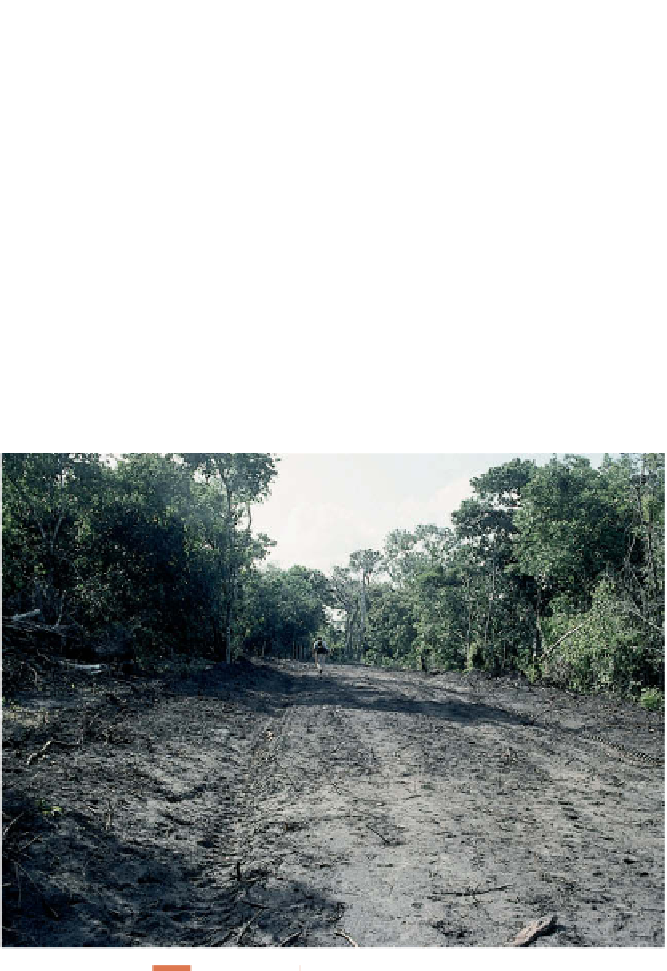Geography Reference
In-Depth Information
Deforestation
Forests cover 31 percent of the total surface of the Earth
from the tropical Amazon Basin to high-latitude North
America and Eurasia. The world's forests, especially those
of lower and middle latitudes, play a critical role in what
biogeographers call the
oxygen cycle
. Atmospheric oxy-
gen is consumed by natural processes as well as by human
activities. Forests counteract this loss through photosyn-
thesis and related processes, which release oxygen into
the atmosphere. The destruction of vast tracts of forest
is called
deforestation
. Ecologists and others warn of
unforeseeable and incalculable effects not only for the
affected areas but for the planet as a whole.
In the early 1980s, the Food and Agriculture
Organization (FAO) of the United Nations undertook
a study of the rate at which forests were being depleted.
This analysis showed that 44 percent of the tropical rain-
forest had already been affected by cutting and that more
than 1 percent was being logged every year (Fig. 13.13).
In 2010, the FAO released a report on the world's
forests with good news: the rate of deforestation world-
wide declined in the last decade. According to the FAO,
during the 1990s, humans deforested 16 million hectares
a year, mostly by converting tropical rainforests to agri-
culture land. Between 2000 and 2010, humans deforested
13 million hectares a year. Lower deforestation rates have
been coupled with tree planting programs, especially in
Brazil and Indonesia. As a result, the “net loss of forests
was 5.2 million hectares per year between 2000 and 2010,
down from 8.3 million hectares annually in the 1990s.”
Deforestation is not a singular process: it has been
going on for centuries, and the motivations for deforesta-
tion vary vastly. Forests are cut and reforested for wood
and paper products; forests are preserved for the main-
tenance of biodiversity; and other forests are cleared for
new agricultural production.
The reforestation (and harvesting) of deforested
areas is not the whole answer to the problem, even if it
could be done on a large scale. Forests in the United States,
for example, consist mainly of second-growth trees, which
replaced the original forest after it was logged. However,
the controlled second-growth forest does not (as the natu-
ral forest did) have many trees dying of old age after their
trunks and limbs become soft from rot. As a result, many
animal species that depend on holes in trunks and hollows
in tree limbs cannot fi nd places to nest (thus, the spotted
owl dispute in the Pacifi c Northwest of the United States).
For them the forest has ceased to be a favorable habitat.
Field Note
“This was one of the most depressing days of this long South
American fi eld trip. We had been briefed and had seen the
satellite pictures of the destruction of the rainforest, with
ugly gashes of bare ground pointing like rows of arrows
into the woods. But walking to the temporary end points
of some of these new roads made a lot more impact. From
the remaining forest around came the calls of monkeys and
other wildlife, their habitat retreating under the human
onslaught. Next week this road would push ahead another
mile, the logs carted away and burned, the fi rst steps in a
process that would clear this land, ending billions of years
of nature's dominance.”
Figure 13.13
Para, Brazil.
© H. J. de Blij.
encouraging other countries to impose stricter controls
over factory emissions.
The Land
Over the centuries, human population growth has put
increasing pressure on land surfaces. More land is cleared
and placed under cultivation, trees are cut down, and cities
expand. The effects can be seen almosteverywhere and are
so extensive that it is often diffi cult even to reconstruct what
an area might be like in the absence of humans. The human
impact on Earth's land surface has several key aspects, the
most signifi cant of which are deforestation, soil erosion,
waste disposal (discussed here) and biodiversity loss.
Soil Erosion
The loss of potentially productive soil to erosion has
been described as a “quiet crisis” of global proportions.
Ecologists Lester Brown and Edward Wolf point out that
the increasing rate of this loss over the past generation










































